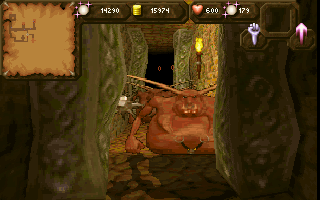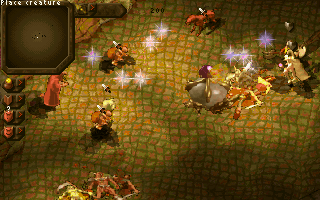

 By Al Giovetti
By Al Giovetti
Introduction: Finally, I get to come up for air. After three days in the dungeon with nothing else to do but sacrifice millions of little apprentice keepers. Just give them a title and they kill themselves for you, literally. That assistant manager program I started is really starting to pay off.
What carnage! My 18 special minions just cut up those good guys.
History: Peter Molineaux and Bullfrog have produced nothing but hits Hi-Octane being the only possible exception. Due to this unerring track record it behooves us to investigate this newest product.
Bullfrog has been talking about this project for almost two years, and it looks like Summer of 1997 will be the release date, extended two years from the originally promissed date. The theme of the Dungeon Keeper warding off invading heros has intrigued gamers since it was introduced.
Plot: The premise is an intriguing one. Turn the tables on the game player, role playing adventurers, and dungeon denizens alike by giving us a game from the perspective of the head monster in charge of the dungeon that the adventurers are invading. As the head dungeon honcho you have to defend against invading hordes of adventurers who are intent on killing your minions, disarming your traps, finding your secret doors, stealing your treasure and artifacts, and, if possible, removing your life force, which is the most heinous theft of all, because it will steal from you everything you hold dear.
As in most Bullfrog games, the denizens can be ordered to do things, but they are just as content pursuing their own objectives. The imps will clean the dungeon, build strong walls, and clean up the corridors if left to their own devices. Should you need them you can order them to tunnel out hallways and even dig for the gold needed to finance other ventures, such as the furnishings for the treasure rooms.
Additionally, should you not want to perform most of the onerous micromanagement tasks the computer can be set to four levels to handle them for you.
All of your evil creatures have personalities and areas in the dungeon
they naturally gravitate to, and once they have found a suitable
location, these monsters will begin to set up house and furnish the area
with their favorite things. Spiders like dusty corners. Vampires like
dark and secluded places to live. Skeletons like to live near the
graves or corpses of expired beings.

Like in the Ultima series of games by Origin, the monsters will also have a daily routine, they will become hungry and venture from their lair to hunt, kill and eat their prey. They are territorial and if their space is invaded they will defend it violently. As the dungeon keeper, the game player must have the gold to attract and pay the monsters, but can also use magic spells to get the creatures of his dungeon to do his (or her or was it an it? - Ed.) bidding.
Monsters must be lured into your dungeon and tricked, cajoled, or disciplined into defending it against invaders. Those who enjoy bondage and discipline will get to torture and discipline their monsters with the back of their mouse hand. While Imps do most of the evil work, the other monsters must be in residence to help defend your domain.
Attributes: Any good role playing adventure has statistical attributes. Each monster has a set of attributes available to the dungeon keeper, including health, hunger, intelligence and others. The game is starting to sound like Theme Dungeon, a version of Theme Park and Theme Hospital.
Artificial intelligence: "Behavioral cloning" allows the game to learn
from your sucessful techniques, forcing you to develop new strategies in
an every changing strategic environment.

Perspective: The perspective for planning and building is isometric third person. The perspective for conflict is first person. The left hand portion of the screen has a control panel that directs types of rooms to build including a lair for living quarters, treasure rooms, hatcheries for food, prison to hold captured adventurers, libraries, and training rooms, to make your creatures stronger and increase dungeon defenses.
Human Speech: Voice overs with live actors will be included.
Graphics: Fully-rotational (as are many Bullfrog games),
texture-mapped, true light sourcing dungeon shows flickering torches and
illuminating fires that also dance and illuminate with constant
flickering flames.

Utilities: All parts of all 25 levels will be editable via a customized Excell spreadsheet.
Multiplayer: Eight player networkable features allow one player to be the keeper and the other the invading heroes. There is a keeper versus keeper multi-player mode. The Dungeon Keeper website allows 256 people to compete in up to 64 dungeons.
Journalists: Alan claims that there will be one castle which is populated by evil monsters and another which holds the Ultima series avatar. In one cut scene you kill the Ultima avatar as the climax to the game. Adrenaline Vault seems to have published the review before the games hit the shelves. Reviewers do not get the games quicker in the shrink wrapped versions. In fact, Electronic Arts sends the games out to reviewers two weeks after they hit the shelves. When the review is published before the game is out, this means that the reviewer is reviewing a beta, which may or may not be exactly the same as the production copy. Reviewers tend to be kinder to beta versions, so companies prefer to send them out for review. This also means that the reviewer did not have a lot of time, if any, with the shrink wrapped product that the public buys off the shelf. Many consider this type of review bad form, while others it is standard operating proceedure. The Computer Show prefers to look at shrink wrapped product. The review is later, but the review is on the product the public buys, not some beta with excuses that the reviewer is expected to buy. And with a product like Dungeon Keeper, (so long in production that we thought they had died, rather than the product) this can be critical.

Publish your own review right here, just email us your text.
References:
Shawn, Adrenaline Vault Review, July 10, 1997, 100%.
Steve Bauman,
www.cdmag.com/strategy_vault/dungeon_keeper_preview/page1.html
Steve Bauman, Computer Player Strategy Plus, issue 70, September, 1996,
pg. 32.
Shawn, Adrenaline Vault Preview
www.zdnet.com/complife/content/960521/feature3/main.html
www.zdnet.com/gaming/content/960517/johnny.html
PC Zone (UK), December, 1995
PC Review (UK), November, 1995
Hyper Mag (Australia)
C & VG (UK), June, 1996
Next Generation, August, 1996
PC Format (UK), November, 1995
CD ROM Mag, November, 1995
Alan Dykes, Computer Gaming World, issue 152, March, 1997, pg. 28.